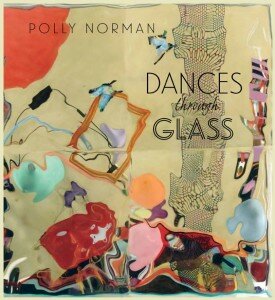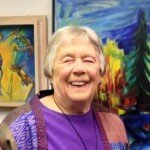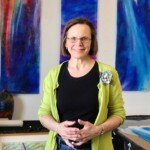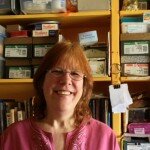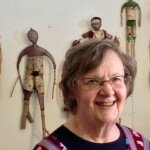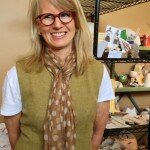- Find us on Facebook
- Follow us on Twitter
- Find us on LinkedIn
- Donate at GiveMN.org
- Join WARM
- Login / Profile
Archive for the ‘artist resources’ Category
|Polly Norman:Dances Through Glass
Monday, November 18th, 2013
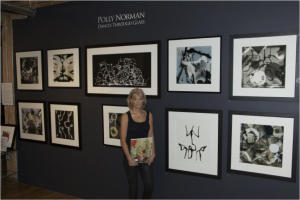
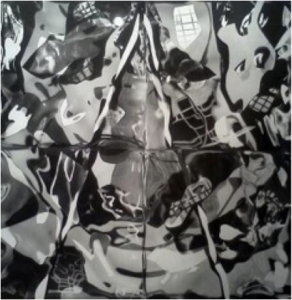
From the WARM Coffee session: by Debra Ripp
Polly Norman refines her vision by shooting through the kind of glass blocks which have traditionally functioned as a standard of business architecture, the result are called “Pollygraphs”. These “Pollygraphs” are her most recent work and are featured in her 25 year retrospective at the Minneapolis Photo Center. The exhibition is complemented by a dazzling book of photographs titled “Dances Through Glass”. The book is available from Polly at her website: http://www.pollynormanart.com/book
Polly’s six year study of drawing and painting at Atelier
Studio Program of Fine Art coincided with her photographic studies of classical dancers. Norman used various photographic filters for those dance works. She then discovered the beauty inherent in glass block by accident at a health club in Chicago. This discovery led her to pure abstractions and floral assemblages shot through Pennsylvania glass block. The glass blocks affect forms both to alter and abstract objects in a lyrical mode.
This might suggest an easy transition but this is not the case. There were plenty of challenges both in the darkroom and in the field. Polly attributes some of the success to her vision to her experience with bi-polar disorder. The stigma around bi-polar disorder still exists and Norman is now a mental health advocate through NAMI (The National Alliance on Mental Illness). Part of NAMI’s mission us to remove the stigma surrounding mental illness.
Tags: artists, Atelier, Dance, photography, Pollygraphs, WARM, woman
Posted in artist resources, exhibitions, Uncategorized, WARM artists | No Comments »
The May Dow Tour
Sunday, July 7th, 2013
WARM BLOG May 11, 13~Dow Building Tour
By Debra Ripp
Bettye Olson Howard, Laurie R. Johnson, Debra Ripp, Karen Searle and Ann Meany are all WARM members but their other connection is that they all have a studio home in the Dow building. The Dow building is located at 2242 University Avenue West and Hampden Avenue in St. Paul’s Creative Enterprise Zone. On May 11 a tour of their studios was the focus of the May WARM Coffee. Each artist gave a 15-20 minute presentation to nine attendees within the environment of their studio. The artists spoke about their personal history in art, techniques, themes and fundamental motivations.
Bettye Olson Howard is a veteran WARM member and Dow artist. She has been a dedicated artist since the 1940’s when she bravely took the break from domesticity that we all dream of. She has been a fulltime painter and teacher since then, in Minnesota for the most part although she also studied in Taos, New Mexico. Bettye was recently honored with a retrospective at the Hennepin History Museum which included many of her abstract paintings from the 1950’s, her vividly flowing watercolors as well as a video interview that took place in Sweden. Bettye is a local treasure with a priceless historical perspective which clearly confirms itself in the work right up to the lovely Easter banner that she recently created for her church. One of Bettye’s contemporaries at the University of Minnesota was Malcolm Myers, many of the artists present at the Coffee had also studied with Malcolm, including myself, and there was a warm remembrance among most of us. One of the themes stressed by Bettye was of balance and faith, painting has helped keep that balance in her life and her advice to women artists is that if you stick it out and think of new ways to create, the urge to create will not abandon you. Her method to revive the creative urge is to approach the natural world in a group of fours; i.e.: seasons and elements.
Laurie R. Johnson’s recent work gravitates between the visual and the literary. She has been working on a story whose themes are vastly evocative about the search for meaningful connections in the world. When she finds herself challenged as to where to take the story, she comes back to the studio and draws from her dreams and memory to illustrate the stories direction. Although she strongly credits her dreams, the drawings are distinctly composed in a strong eventful narrative. The depiction of a crow in the drawings unleashed a lively discussion among the attendee’s about symbolism, archetypes and folklore and it was agreed that the crow could represent a narrator or a reincarnated former character in the story. Laurie also works steadily to develop her discovery of glassine material, creating luminous banners in vivid or moody colors. Lately she has extended that exploration into three dimensional sculptural forms. Laurie credits her muse and teacher, the late Gabrielle Ellertson of the Women’s Institute, as a lasting and reliable influence in her work.
I am Debra Ripp, and my studio was next in line in the tour. My latest creation has been my focus website and I am happy to say that it had been launched shortly before this tour. You can visit at www.tobersonstudio.com, and I hope you do, I am completely open to feedback! My webmaster, WARM member, Debra Trejo, was present at the tour and I was more than happy to introduce her! I can, without reservation, recommend Debra to anyone interested in setting up a website. She is wonderful and very patient!
I like that our themes, among the artists presenting, are somewhat intertwined. It seems that we all rely on something in our relation to the world, whether it is balance, connection, faith, or navigation. In my work I rely on the function and perspective of my characters that I create. I spoke at length about my main character, Toberson, how he was created and what his function is. This is the subject of my very first blog on my website. The gist is that Toberson is my compass and my filter as far as the world is concerned, before I created him, I felt rudderless and unfocused as to how to go about my duties as an artist. He helps to keep me from distraction so I can explore other ideas such as my lamp series. At one point last year there was an issue of dysfunction in my lamp world in which every lamp I had at home quit on me and I couldn’t bring myself to throw them away. I brought a selection to my studio and began to create still lives. From this exercise, two series has emerged, a collection of vignettes /master collage drawings and series of banners depicting a forest of lamps. My title for these projects is “The Light that Failed Me:subtitled: What do you do if essential things in your life are suddenly absent?” I continue to develop characters and places for them to travel to and this reflects my interest in the theme of the journey and what it means to maintain meaning in your life and art.
Karen Searle creates abundantly unique fabric and needlework art! We were able to view many examples which varied from dollmaking which embraces bark elements, to embroidery and extremely intricate lace stitchery. These are not your mother’s samplers! Her work is a statement about women’s creativity and ingenuity in the world. The exceptional piece for me is one I have marveled at whenever I have visited her studio. It is an ordinary dining room chair that she had collected, then embellished in multicolored yarn, embroidered, sewn and staffed with birds and other accoutrements. She is, at heart, a collector, not just of materials but of thoughts and lyrics. One of her lace self portraits is an image of her as an older woman and it borrows the lyrics of a Beatles song “When I’m sixty four” another quotes “Yesterday” as in “Yesterday came suddenly.” In other works she has incorporated acrylic paint along with sewn elements, stating that ” it just needed sewing”. Her work inspired a discussion in just how deeply these sewing urges go in women and how far they can be taken and why, it seems that it is couched in the caretaking tradition and doesn’t really need to be obliterated in the name of feminism! Karen has been a strong presence in the Dow building and at the Textile Center as well as leadership in the WARM Mentor/Protégé program.
Ann Meany is at home in her ceramic studio in the basement of the Dow building, complete with her own kiln. Ann’s main theme is to commemorate her family relationships with ceramic symbols of her feelings, such as the swaddled heart form she built to the memory of her father and an earlier mosaic piece (as seen on her page at FineArtAmerica) dedicated to of her late brother. Ann’s wish is to portray “ the unlimited potential of connections on earth and in the spiritual world.”
She also has a love for the spiral shape and ferns and her work reveals a general desire for the action of the form. Ann also had a collection of ceramic playful figurines modeled both after her adopted African American daughters and inspired by the book “Happy to be Nappy”. She brings varied and rich experience to her studio since she has worked as a movement teacher, a wellness director and a guardian ad litum for children at risk in the Court system.
This tour turned out to be a successful sharing of thoughts questions and discussion. There were mutual benefits for the artists and attendee’s in the gathering and hopes that we could do this sort of event again. We actually did a tour at the Casket building last year, it was just as stimulating and fun as this one. The WARM Programming Committee is open to ideas for Coffee’s like this, please don’t hesitate to talk us!
Posted in artist resources, events, WARM artists | No Comments »
Craft Emergency Relief Fund for Artists
Tuesday, October 11th, 2011
WARM member Chris Madsen recently attended an emergency preparedness workshop for artists presented by Springboard for the Arts. Here is what she learned about how artists can save themselves time and money by being prepared.
What happens to your art business if water seeps into your basement? What if it floods? What if an electrical fire destroys your studio next to your home? What happens if your kiln catches fire? What if your computer is stolen, with all your images? Your finances? Your mailing list? What happens if a tree falls on your home studio, after straight-line winds rip it up? What if a student is injured in your house while attending a workshop? What would you do first? Where would you turn?
Disaster Preparedness training: a topic both “boring and terrifying” according to CERF Director of Programs, Craig Nutt. While it’s human nature to want to avoid the issue, it’s in our best interest to address it before something happens. Actually artists today are much luckier than those in the past. First: thanks to the media, we’ve seen what really happens after disasters, whether hurricane, fire, flood or tornado. Forewarned is forearmed. Second: we have access to more resources than at any time in the past. It costs less now to protect ourselves in both time and money.
On October 6th, WARM, along with several other local arts organizations, was invited to attend a training session by the non-profit agency CERF, Craft Emergency Relief Fund. CERF was founded 26 years ago after an artist and an administrator participated in yet another pass-the-hat following a disaster. They decided to be proactive and pull together resources, grants and information ahead of time, to prevent what could be avoided and to offer immediate relief for that which was unavoidable.
The presentation on Thursday included before and after pictures of studios lost to disaster as well as video testimonies from artists, some of which are on the website, under “Artists’ Stories.” To make the subject even clearer, John Herbert, of Legion Arts in Cedar Rapids, IA, came in person to talk about life after the 500-Year Flood of 2008. His organization escaped by being on an upper floor, so it was poised to help other artists cope, locate gallery venues and funnel donations totalling $18,000 in small grants to artists in need.
In 2007 CERF made a survey of 3,000 artists which revealed that 69% of working artists were not properly insured while 22% of them mistakenly assumed that their homeowner’s policy covered their home-based business.
For this training, CERF brought in an insurance agent to talk about property and liability coverage. The good news? A policy that cost $3,500 in 1994, costs $350 in 2011, for the same coverage. You can add a rider onto your homeowner’s policy to cover clients that come to your house, sometimes for as little as $12 a year. One day special event coverage can cost as little as $150. Insurance information is on the CERF website under the Studio Protector Online Guide; more information can be found on Fractured Atlas, a nonprofit organization that operates nationally to serve artists.
CERF’s Studio Protector Online Guide is loaded with essential information to both prevent disasters and to deal with them when they occur. You’ll find practical information, like how to salvage a wet cell phone or how to hold off mold from documents utilizing freezers until you have time to dry them. You’ll also find links to organizations that provide specific resources on finances, loans, insurance, outreach, advocacy, etc. They’ve attempted to keep this website lean and meaty, so it’s pertinent and useful, yet not overwhelming. It’s completely free to use.
For those who like hard copies, CERF also produced a resource called The Studio Protector available for $16, or at wholesale for orders of 10 or more. It’s an incredible piece, heavily designed to make maximum use of space. It broaches many of the essentials from the website in easy to understand graphics and text, covering a wealth of topics including evacuation, art, asset and archive protection, clean-up tips as well as physical salvage and e-salvage. It’s a joy just to open, spin and pull out the separate sections. There’s even a removable booklet to put 911 numbers, emergency contact and art contact information that you can fill out before trouble strikes.
This presentation was offered through Springboard for the Arts, an organization whose mission “is to cultivate a vibrant arts community by connecting artists with the skills, contacts, information and services they need to make a living and a life.” If you haven’t already become familiar with their work, now is a good time. Click on the link to check them out. Then, before you think about it too much, do two things: 1) click on CERF to start the process of protecting your art business. In Minnesota, we’ve seen what tornadoes and flooding can do. 2) Tell another artist or arts organization about these resources. Let’s make art disaster preparedness go viral!
—
Chris Madsen is an artist who does Photoshop collage using antique photographs surrounded by needlework, symbolic and floral images; and makes tiny polymer clay houses with doors that open. Chris also has an art blog, Everyday Friends Art, and an Everyday Friends Art Etsy site.
Tags: CERF, Chris Madsen, Craft Emergency Relief Fund, disaster preparedness, Everyday Art Friends, Fractured Atlas, property & liability coverage, protect your art, Studio Protector Online Guide
Posted in artist resources | 1 Comment »
-
You are currently browsing the archives for the artist resources category.
-
Pages
-
Archives
-
Categories
- artist resources (3)
- events (8)
- exhibitions (4)
-
mentors (22)
- mentor intensive (16)
- slides (9)
- Uncategorized (10)
- WARM artists (11)
